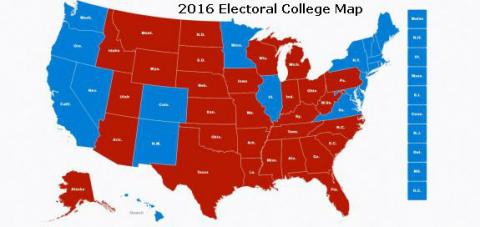
The populist-conservative agenda promoted by President Trump, especially the nomination of Judge Neil Gorsuch to the Supreme Court, can move through Congress only if at least eight Democratic senators are willing to vote to end the filibusters being threatened by many liberals. The 52 Republicans senators, even if they remain united, cannot provide the 60 votes needed for cloture.
Winning over eight of the 48 Democrats may seems impossible, but at look at the 2018 Senate election map provides real hope. Ten Democratic senators are running for reelection in states that voted for Donald Trump, four of which have not voted for a Democratic president since at least 1996. These senators have to take into account that hostility to Trump’s populist-conservative agenda will turn key swing voters against them, making reelection difficult or impossible. Republicans picked up six Democratic senate seats in 2010 and nine in 2014. There is no reason to think it cannot happen again in 2018 if Democrats vote against the will of their constituents.
A state-by-state look at the ten confirms that all of these senators have reason to fear the next election.
Florida
Sen. Bill Nelson is completing his third term, but Florida began moving back to the right after it voted for Obama in 2008. Obama barely carried it in 2012, and it went for Trump last year while GOP Sen. Marco Rubio won a solid 8-point victory. The state has not elected a Democratic governor since 1994 and Republicans hold every elected state office. Gov. Rick Scott and several congressmen have been mentioned as challengers to Nelson, so he is likely to have a strong opponent.
Indiana
Sen. Joe Donnelly was elected six years ago when his relatively moderate voting record in the House allowed him to just barely slip past an opponent who was pounded mercilessly by the liberal media. Indiana voted for Trump by 19 points last years, while also electing a Republican senator and governor to open seats against strong competition. Donnelly has been identified by Senate Democratic Leader Charles Schumer as one of the five most vulnerable incumbents next year. He will probably have strong opposition from one of several Republican House members.
Michigan
Sen. Debbie Stabenow would probably not be considered vulnerable if Trump had not shocked political “experts” by winning Michigan last year. Yet Michigan had already demonstrated Republican strength in everything except the presidency. Republicans hold all statewide elected offices and solid majorities in both houses of the legislature. Nine of 14 congressmen are Republican. If a strong contender emerges, this seat could be competitive. Stabenow herself understands that. She quickly tried to warm up to Trump voters after the election, telling a Politico reporter that “the kinds of things he was talking about are the things that I fight for every single day.”
Missouri
Sen. Claire McCaskill represents a state rapidly trending away from Democrats. It not only gave Trump a 19-point margin; it also elected a Republican governor and reelected a Republican senator despite frequent predictions by “expert” pundits that Democrats were about to break through in both races. McCaskill would almost surely have lost six years ago had not two tea party candidates split the vote in the Republican primary, allowing a weaker candidate to win the nomination. McCaskill is another of the top five targets identified by Schumer.
Montana
Sen. John Tester is another obvious target, and one of Schumer’s top five. Tester has been elected twice in close races, but never received as much as 50% of the vote. Last year Montana not only gave Trump a landslide win, it also elected Steve Daines as senator with an even larger vote. The left-wing Daily Kos looked at Tester’s race and declared it “worrisome.” Rep. Ryan Zinke’s move to Trump’s cabinet has removed one strong contender, but Republicans should be able to nominate someone who will give Tester a strong contest.
North Dakota
Sen Heidi Heitkamp was a surprise winner in 2012, squeaking into office with just 50% of the vote. North Dakota, which was once quite competitive for Democrats running for the House and Senate, has been trending away from their party. Clinton received just 28% of the vote, while Republican Congressman Kevin Cramer (running statewide in this one-district state) was easily reelected. Schumer puts Heitkamp among his five most endangered, and with very good reason.
Ohio
Sen. Sherrod Brown is a favorite of the far left and was mentioned as a vice-presidential candidate for Hillary Clinton. That’s not going to help him in a state that gave Clinton just 44% of the vote. Brown won his second term six years ago with just 51%, an ominous decline from 56% in 2006. Republican Sen. Rob Portman won his reelection last year with a resounding 57%. No wonder the Daily Kos admits this race will be “competitive” and the Cook Political Report ranks it as no more than leaning in Brown’s favor. The 2012 Republican candidate, anti-establishment State Treasurer Josh Mandel, has already announced he is running again.
Pennsylvania
Sen. Bob Casey, much like Sherrod Brown, saw his 2012 reelection margin greatly reduced despite the coattails of Barack Obama. Following a year in which Pennsylvania surprised much of the nation by going for Trump, Casey is now looking vulnerable. With several GOP congressmen thinking about the race, Casey may have to hope that the strongest candidate will decide to run against Democratic Governor Tom Wolf, who may be more at risk than Casey.
West Virginia
Sen. Joe Manchin has maintained his popularity in West Virginia by distancing himself from Obama, Clinton, and the national Democratic Party. That may not be enough after Trump carried the state by 42 points, and Schumer has put Manchin on his top five list. Given that Manchin has already demonstrated that he cares little about loyalty to his fellow Democrats, he can be expected to support the Trump agenda whenever he knows it has support back home.
Wisconsin
Sen. Tammy Baldwin won her first term with just 51% over a weak establishment Republican and with the help of Obama’s coattails. She is not likely to be so lucky in 2018. Wisconsin last year confirmed its recent move toward the Republicans by not only voting for Trump, but also reelecting Tea Party Sen. Ron Johnson, whose defeat had been predicted almost unanimously by the “experts.” Gov. Scott Walker will be running for a third term, and he is likely to provide coattails for Baldwin’s opponent. The fact that Trump and Johnson carried Wisconsin in 2016 with clearly different, though overlapping, coalitions shows that Republicans have multiple paths to victory here.



